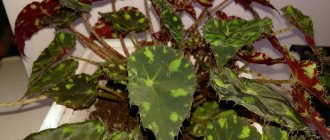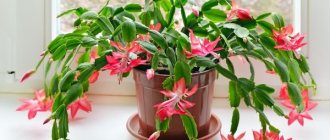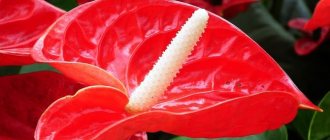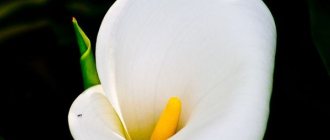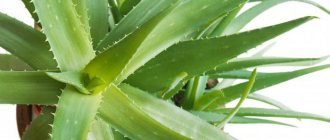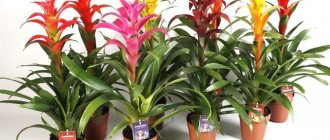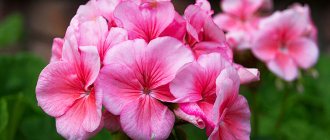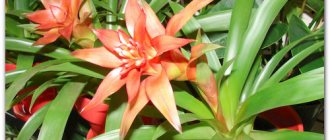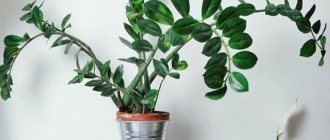If you are more attracted to greenery rather than flowers in indoor plants, feel free to choose reo: this crop blooms really modestly, but its leaves are very beautiful.
True, the concept of “green” can be applied to them with some stretch.
Painted in two primary colors (for example, green on the front side and purple on the back), they are dotted with many stripes of other, additional shades, which makes the plant especially elegant.
Names and brief descriptions of indoor flowers with purple leaves
The unusual color of the leaves can be of various shades: from light lilac to deep purple. It can be uniform, can be located on both sides of the leaf at once, and there are options where this color is presented on one side - only on the top or bottom, while the other part remains the usual green. Purple on both sides are the well-known wood sorrel (night butterfly) with small triangle leaves, irezine (which needs a large amount of light to maintain the brightness of the color). The types of Herbst irezine and Purple Lady irezine are monochromatic.
Stromanta as a flower garden decoration
The upper side of the leaves is purple
Among the whole variety of indoor flowers, painted in this unusual, unusual shade only on top, the most popular is hemigraphis alternating. There are more than 100 species of this plant in nature. At home, ampel and semi-ampel forms are grown. It can be perennial or annual. The plant is whimsical, but looks very impressive.
With proper care, the ovoid, serrated leaves turn purple on top (its saturation changes depending on the lighting), while remaining light green on the reverse side.
The underside of the leaves is purple
There are other plants with leaves that are purple only on the bottom. The most common among them:
Reo during the flowering period
Note! All plants in this group may change color slightly depending on the lighting.
The magic of an indoor flower
The magical properties of Tradescantia to this day arouse genuine interest among esotericists and lovers of studying mystical phenomena. While in the house, the flower protects its owners from witches and evil spells. Protects from the evil eye, envy, and evil tongues.
NOTE! The more amazing Tradescantia flowers there are in the house, the more reliable and stronger the protection.
If a black streak has set in, the plant will absorb negative energy, trying to clear the space of negative aura as quickly as possible. Having been filled, the savior slowly dries up and dies.
Indoor flowers with purple stems
Flowers grown on a windowsill very often have purple “trunks”. There are representatives of home flora that have such original stems:
Purple indoor flowers can decorate any room and bring a little variety to every interior. And it doesn’t matter at all whether it will be painted in this color in whole or in part. The most important thing is effectiveness and unusualness. As a rule, such plants are not too picky, and all they need is as much sunlight as possible to make the color brighter.
Source
What does the flower symbolize?
The reo flower or Tradescantia capillary is a perennial decorative foliage plant, according to the ancient Chinese teachings of Feng Shui, it symbolizes peace, peace and harmony. Studying signs and superstitions, it is clear that it brings health to the owner, improves the condition of the cardiovascular system, and gives peace of mind.
The flower absorbs negative energy that comes from someone and protects against external negativity. According to the sign, in order for his actions to be revealed and intensified, the rheo is kept healthy. A sick and wilting plant will not be beneficial for its owners.
Oxalis triangularis (Oxalis)
An indoor herbaceous plant, it belongs to the sorrel family.
It grows naturally in South Africa, Europe, South and Central America.
Very popular among flower growers due to its unpretentiousness and decorativeness.
The foliage of this plant has a sour taste.
This flower is distinguished by its unusual triangular leaves.
On thin stems there are trefoil leaves that look very much like butterflies. The upper side of the leaf is more purple in color, while the lower side is less saturated.
In the evening, the leaves close and become triangle-shaped.
During flowering, they produce pale, delicate peduncles with light lilac flowers.
For complete care you need:
How to reproduce?
It is better to combine the propagation procedure with spring transplantation - the indoor flower will grow faster. Select soil that is loose and light, rich in humus. A mixture of humus, leaf and peat soil and coarse sand is suitable. Heat the mixture in the oven or freeze it in the freezer for two days before using.
Propagation by cuttings
This method of reo propagation is the easiest and fastest.
- Cut off the stalk with a sharp blade. You can choose any place for the cut, but between two buds. Pre-treat the blade with a weak solution of potassium permanganate.
- Place the cutting in a glass of water or directly into the soil, deepening it above the lower bud. The cut can be treated with Kornevin or powdered with activated carbon, but do not plant it immediately after the cut - let it sit for a day and dry.
Seeds
Seeds are planted in a common container and kept at temperatures above 20 degrees . Humidity is not particularly important, so you don’t have to cover them with film. The first soil for sowing is a mixture of river sand and peat; after diving into individual pots, use a more nutritious mixture.
When trying to obtain seed material on your own, please note: only the reo variety with green leaves is suitable for this.
Variegated “parents” do not pass on their color during seed propagation. To work, collect small whitish leaves growing inside the “boats” in the axils of the xiphoid leaves (near the trunk), dry them and plant.
Ginura vine-bearing
There are several varieties of ginura. However, the most popular and unpretentious ginura is the climbing ginura.
Belongs to the Astrov family. The homeland of growth is exotic countries: Asia, East Africa.
The culture is ampelous and has long creeping stems, approximately 50 cm long.
Velvety leaves are oblong, wavy at the edges and pointed towards the top. They have an unusual two-tone color. At the base the leaf is purple, and in the middle of the leaf there is a sharp transition to emerald color.
The leaves and stems of the plant are covered with fleecy fringe.
Produces yellow, dandelion-like flowers.
Care requirements:
Diseases
If a houseplant does not look entirely healthy, try to understand the reasons and, if possible, eliminate them:
- small leaves - lack of nutrition and light;
- yellow spots – sunburn;
- growth retardation and loss of basal leaves - excess moisture;
- pale colors, thin long stems - lack of light;
- dried, brown tips of the leaves - too much dryness in the room;
- wrinkled leaves - cold or bleached water for irrigation;
- loss of springiness – low room temperatures.
First aid to the victim must be provided, oddly enough, also with water - arrange a warm shower for the patient.
In this way it will be possible to wash away the pests. If the leaves are severely affected, they will have to be removed.
TIP : transplanting rheo into another pot with new soil is effective, while the roots affected by the disease should be cut off.
Irezine
A bright, picturesque, unpretentious plant.
Belongs to the Amaranth family.
They grow in their natural environment in Australia, America, and the Antilles.
On bright pink stems, spectacular glossy leaves of a bright purple hue are located opposite. They can be oval, round or slightly elongated.
The inflorescence is capitate, spike-shaped.
The most popular types are Linden irezine and Herbst irezine.
Suitable growing conditions:
Where is the best place to put the plant?
Indoor reo with bright purple leaves prefers a lot of light, however, direct sunlight is not for it. It is better if the pot with an exotic plant is placed in partial shade. Constant exposure to the sun is fraught with burns and fading of the leaves.
If you move the reo deep into the room, where there is little light, the shoots will stretch out and become dull. The flower will get sick and die, which, according to superstitions, is very bad - the house will be left without protection. A suitable place for Tradescantia would be an eastern or western window, where the leaves will not be damaged by the scorching sun at midday.
Important! If the pot is on a southern windowsill, then shade it during the daytime.
Based on signs and superstitions, as well as the ancient Chinese science of Feng Shui, the flower is placed next to the workplace, in the bedroom or living room, where family members constantly gather.
Setcreasia purpurea (Tradescantia pallidum)
Spectacular and hardy, hanging plant.
Its homeland is Mexico and its highland parts. Grows together with cacti and agaves.
The stems and leaves are colored violet-purple with a greenish tint.
The leaves are narrow, up to 3 cm wide, oblong in shape, narrowed at the top. Their length is up to 10cm.
It blooms for a long time from May to August, with small pink flowers.
Growing conditions:
Setcreasia should not be irrigated from above to avoid the appearance of light spots on the leaves. Therefore, to maintain humidity, place a container of water or a tray with pebbles or expanded clay next to the plant.
Who can you give a reo flower to?
According to signs and superstitions, reo is suitable for insecure and self-contained people. It helps to reveal the potential of the individual and gives confidence.
You can give a flower to a childless couple or people in love. The main thing is that it is done from the heart.
Reo develops talent; it is a flower for creative individuals. A striking example of this is a lot of new works, crafts, paintings, and works. It's easy to create and create next to him.
Superstition or not, but reo is a good healer of soul and body. It is given to wish health and prosperity to the family.
Reo (Tradescantia capillata)
One of the most unpretentious flowers.
Some scientists attribute it to the genus Tradescantia, but there is another opinion according to which it is assigned to the genus Reo.
Throughout the year it has decorative, massive, purple leaves. Its leaves have a beautiful, graceful curve.
It is ideal for the interior of any room. And in the summer it feels good on the balcony or loggia.
Favorable conditions:
Indoor plants with purple leaves bring variety to the usual green world. They improve the mood with their variegated colors.
What they have in common is ease of care. As a rule, they require a lot of light for their bright colors, moderate humidity and watering.
Source
Signs about the reo flower
There are many signs around the exotic reo; the flower is shrouded in superstitions. Lovers of indoor plants really believe that it works wonders. For example, that Tradescantia capillata helps conception. According to legend, couples who have not had children for a long time will soon experience the joy of motherhood. Women claim that reo helps to bear and safely give birth to a child.
Another superstition is associated with the influence of the flower on married life - according to legend, it helps to establish love relationships and smoothes out disagreements between partners.
Signs about reo associate the flower with peace of mind. This is especially important for those who have recently lost loved ones or relatives. The flower literally brought them back to life and did not let them give up.
Signs and superstitions indicate that after planting the reo, many people showed a penchant for creative activity, and all the work and projects they started were successfully completed.
Important! If the owner of the reo is an evil person or has planned something bad, then you should not hope for a positive outcome of the matter. The flower will take revenge on the spiteful critic.
Names of purple indoor flowers
The purple color of the petals looks advantageous in a classic or minimalist interior; such plants always attract attention. There are many varieties of domestic crops with light or dark purple buds. And each of them requires proper care and attention. In this case, the flower will delight you with flowers all year round. If you do not provide the plant with comfortable growing conditions, it stops blooming and eventually dies.
Himalayan geranium. The shrub plant reaches only 30-60 cm in height. It is distinguished from other species by large flowers with lilac petals of varying degrees of brightness (from light lilac to rich, with pinkish veins).
Achimenes Ehrenberg. Reaches half a meter in height. It has straight and thin stems on which grow medium-sized leaves with a bright green color and clearly visible veins. The flowers are purple at the edges and deep lilac closer to the center. The flowering period occurs from the beginning of spring to the end of autumn.
Saintpaulia. There are many varieties of the plant. They all differ from each other in the color of their buds. They are terry or glossy, light lilac or bright purple. Plants with a heterogeneous shade that combines several colors at once (duochrome, chimera, bordered) look unusual. Saintpaulia grows up to 30 cm in height, has thin stems and a shallow root system. Roots well in loose soil mixed with sand.
Gloxinia. The plant has a tuberous root system, thin stems surrounded by double green leaves. Buds with a diameter of 5 cm bloom at the tops of the stems. They are distinguished by their border color - white at the edges and dark lilac in the center. The shape of the petals is wavy, heterogeneous. Flowering occurs in the summer and lasts 2-3 months.
Calla purple. It has the same structure of stem, leaves and flowers as the classic white variety. A distinctive feature of the plant is the deep purple hue of its petals. The color is uniform, inclusions of other colors are rare, which depends on the type of crop.
Passionflower. An exotic plant, notable for its unusual flower shape. The petals are painted in different shades of lilac. In one inflorescence there are light and rich tones. In the middle there is a corolla, which consists of bright purple threads, and a yellow anther. The leaves have a complex shape with jagged edges. The stem is thin, growing upright.
Stapelia shaggy. The plant belongs to the category of succulents. It has strong and fleshy leaves, thick stems in which moisture accumulates. Buds form at the tops of the stems, which then bloom into bright purple, star-shaped flowers. The flower is double, covered with barely visible fibers. Some varieties have light veins on the petals.
Streptocarpus. Dark terry leaves of a green hue are collected in a basal rosette. Stems rise from it to a height of 20-30 cm, and on their tops purple, funnel-shaped flowers with white veins and a light center are formed. The buds reach 5-7 cm in diameter.
Fuchsia. An evergreen exotic plant with thin green branches-stems on which bright purple flowers of unusual shape bloom. They have a corolla-shaped cup and a tube-shaped corolla. The surface of the petals is terry or simple. The flower is easy to care for, but in winter it needs rest.
Under the wrong conditions, the flowers first change color, become dull, and become covered with spots. The emergence of such a situation indicates that it is necessary to reconsider the care of the crop.
Hemigraphis
In the wild it is an evergreen perennial. Today there are more than 100 species growing in natural conditions. In a cultivated form at home, only 4 items are suitable for growing:
- Widely pitted. A low-growing plant, the shoots are colored red and spread widely. When the stem touches the soil, it quickly takes root due to the presence of nodes on it. The tops are raised upward. The leaves are lanceolate, with jagged edges up to 6 cm long. The top plates are violet-green, the reverse side is red-violet. At the top of the stems there are inflorescences in the form of heads, collected from small petals; the entire bud does not exceed 1.5 cm in length. The color is white.
- Alternating . The second name is red ivy. The length does not exceed 50 cm. The shoots creep, have a brown tint, the tops rise to a height of 7 cm, and take root at the nodes. The leaves are ovoid, up to 9 cm in length, shaped like a heart. The color above is silver against a gray-green background, and below it is lilac or violet. The surface is glossy. The petioles are short, up to 5 cm, brown, and pubescent. The flowers are white, inconspicuous, no more than 1 cm long, bell-shaped. Can be used as a ground cover or hanging form.
- Colored (flaming ivy). A herbaceous perennial that grows in bush form, found in the wild in Java and the Philippines. Up to 25 cm in height, it has creeping shoots that easily take root on the soil surface. The leaves are wrinkled, violet-blue with a silver tint above and a red tint below. The flowers are white, small and almost invisible.
- Exotic. This variety is used to decorate terrariums and aquariums, and also as an indoor flower. It reaches a height of 40 cm, the leaves are purple with green spots, and the reverse side is red with veins. If the plant is grown in cold water aquariums, the foliage becomes a solid green. The stem is straight, with flexible lateral shoots growing on it.
- ground cover plant, with herbaceous, creeping shoots growing upward;
- the leaves have different shades of purple with dark green veins or spots that turn silvery in daylight;
- leaf blades are located on short petioles, can be ovoid or lanceolate, with small denticles along the edges;
- inconspicuous white flowers are collected in bunches, up to 1.5–5 cm in diameter, in the form of spikelets;
- the plant forms aerial roots, which are used for propagation and cultivation as an ampelous species.
Beautiful bright leaves of hemigraphis with silver stripes overshadow the faded, almost invisible flowers. The height of the bush in cultivation reaches 15–30 cm, in the wild - about 60 cm. The diameter of the bush is 45 cm.
What house plants have this leaf color?
Gardeners also prefer to grow plants that have unusual lilac or purple leaves. There are many varieties of such flowers. They fit well into the design of the house and are considered original due to their appearance.
Hemigraphis. An evergreen plant with lilac foliage. At home, 4 varieties of hemigraphis are grown from a wide variety of species:
Ginura. Lush fast-growing shrub with small lilac leaves. The stems are creeping or upright (depending on the variety), grow 50 cm in length, hollow inside. The leaves are colored deep purple at the bottom and have bright green veins on top. They are covered with light fluff, giving them a spectacular terry surface.
Why do you dream about this flower?
For the most accurate interpretation of the dream, some details that emerged during the dream are taken into account.
- I dreamed about Tradescantia - changes will soon occur in your personal life. Perhaps a person will appear who will destroy the existing routine and fill life with new meaning.
- For a man, such a dream promises a meeting with a lady who knows how to run a house and is able to create comfort in the house.
- For a woman, sleep is interpreted as obvious attention from the opposite sex.
- I dreamed of a crowd of people - a magnificent celebration dedicated to a wedding or birthday is expected.
- Animals were present in the dream - get ready to meet an old friend or long-time girlfriend.
What are the features of cultivation and care?
Any indoor culture needs to create optimal conditions for normal growth and development. Care consists of the correct choice of substrate (soil), watering, fertilizing, creating suitable air temperature and lighting:
How to water and fertilize?
Watering and fertilizing are mandatory procedures in caring for indoor flowers. It is recommended to water the plants early in the morning or after sunset (in extreme heat and sunlight, moisture evaporates faster from the soil and does not have time to be absorbed into the roots). When watering, you need to pay attention to the surrounding conditions: the higher the air temperature, the more abundant the moisture should be. This means that in spring and summer, purple flowers are moistened 2-3 times a week; in winter, it is recommended to reduce watering.
The soil is fertilized in the spring, when the roots and other parts of the plant are in a state of active growth. During this period, nutrients are more readily absorbed by the crop, and accordingly, the procedure gives better results. If necessary, for example, if poor soil is used, it is recommended to repeat fertilizing in the fall.
Transfer
It is recommended to replant indoor plants in early spring, when all life processes are activated after winter dormancy. It is necessary to carefully remove the flower from the pot without touching its roots. Drainage is placed in the container for transplantation and a little soil is poured. Place the plant there, sprinkle it with substrate, and moisten it abundantly.
It is better to fertilize and prune crops 2-3 weeks after they are moved to a new pot. This procedure must be carried out as the plant grows, since some varieties require frequent replanting, others - once every 2-3 years.
Diseases and pests
Often, a houseplant begins to turn yellow, turn black, and its leaves become covered with spots and wormholes. The reason for this is diseases and attacks by insect pests.
Diseases are divided into viral and bacterial. The most common viral pathologies of domestic plants include mosaic and plant jaundice. The first disease, if treated in a timely manner, does not cause serious harm, but worsens the appearance of the crop, as it is accompanied by the appearance of yellow spots on the leaves. Jaundice is considered a more dangerous pathology, as it leads to rapid withering and death of the flower.
Bacterial diseases include:
Indoor flowers are also susceptible to pests, such as:
The plant must be treated with an insecticide; if necessary, repeat this procedure after 14 days until all symptoms disappear completely.
Description of features
The rheo flower (in Latin called Rhoeo Hance) belongs to the species “Tradescantia variegated”. Sometimes they write “reo”, it is often called reo tepalata , because its already modest, inconspicuous flowers managed to hide under the leaves-bracts, as if under a blanket.
This botanical feature caused people who studied the plant to associate it with a mythological boat that floated down the Nile, in which lay a baby. It was discovered and saved by an Egyptian princess, and the plant was named reo (by the way, Reo is the name of a forest nymph) and began to be called “Moses’ boat” or “Moses in a basket.”
In its homeland, in the tropical zone, the plant does not know periods of rest. This, however, does not mean that there the reo rolls around like cheese in butter: in dry times, it has to fight for life, using the moisture previously accumulated in the succulent leaves.
At home, this amazing property of the plant helps it stay fresh all year round. And the leaves are truly unique: their length ranges from 25 to 30 cm, width – 5 cm, and thickness – 0.5 cm. Thanks to these parameters, even a single plant, if it is also well-formed, makes a rich, lush bouquet.
Reo variegated (bedspread)
Reo is a perennial crop that is quite easy to care for . In home floriculture, this species is used more often than others. The leaves are dense, shiny, violet-purple on the “underside” and dark green, with longitudinal white stripes on the “front” side.
The flowers (by the way, they can appear at any time of the year) are white and quite spectacular, even despite their miniature size. The “trunk” of the rheo is voluminous enough that, like the “crown,” it contributes to the accumulation of fluid reserves.
Read also: DIY thread keychains
The reo palette can also include colors that are unusual for leaves, such as pink or pink (Stripe in Pink variety), burgundy (Compacta).
Reo yellow
Reo yellow is not so often used in indoor floriculture, perhaps because yellow colors create the illusion of fading autumn foliage, and we want fresh, spring colors.
Nevertheless, this type of reo looks very original.
For example, the Vittata variety (as pictured) impresses with its combination of dark purple and intense yellow color.
In the spathacea Vittata variety, the beautiful sandy shade has completely replaced the purple colors.
There are also varieties with a beige color.
Although reo is not a capricious flower, it is very responsive to good care . If you take care of it according to all the rules, reo can become a real decoration for your home flower collection.
Light and temperature
Reo requires good lighting, but direct sunlight can be detrimental to it . The best choice is windows facing west and east.
If you place the reo plant on a southern windowsill, your green pet will need light shading. On northern windows, lighting may be required, because if the flower does not have enough light, its stems will begin to stretch.
This plant should not be exposed to sudden temperature changes . We must try to maintain the air temperature around 20 degrees in summer and at least 15 in winter.
Watering
The amount of watering is adjusted depending on the season:
- from spring to autumn - intense,
- in winter – moderate.
The same approach can be applied to spraying - such water procedures are extremely pleasant for the plant, however, in the cold season they should be carried out less frequently, but not completely eliminated, since due to the operation of heating radiators in the room there is quite low air humidity.
Reo is a moisture-loving crop, so the soil in the pot should always remain moist.
And so that the roots do not suffer from excess moisture, you need to ensure high-quality drainage in advance.
A good option for increasing humidity levels is to place pots on trays filled with wet moss or pebbles.
By regularly adding water to the tray, you will be able to maintain the moisture level required by the plant. The water should be at room temperature and soft in composition. After half an hour or an hour, the water needs to be poured out of the pan.
Fertilizers and fertilizers
Reo needs fertilizers and fertilizing from the first month of spring to August inclusive. They need to be done once every two weeks. In autumn, the number of fertilizing is reduced, in winter - they are stopped completely.
The fact is that in a state of relative dormancy, the plant consumes less nutrients and they begin to accumulate in the soil, which can subsequently have a negative effect on the flower.
It is advisable to use complex mineral fertilizers, as well as organic fertilizers, strictly in accordance with the volumes specified in the instructions.
Transfer
Adult specimens do not require frequent replanting; it is enough to do it once every 3-4 years . With “youth” this procedure is carried out every spring, usually using the transshipment method. First, the top layer of “old” soil, in which there are no longer any nutrients left, is removed.
Each time the pot is taken a little larger than the previous one , and the shape is always chosen the same - with a large diameter and insignificant depth. The fact is that the rheo root system grows more actively in width than in length. Drainage must be laid at the bottom. For more information about rheo transplantation, watch this video:
Description of the reproduction process with photos
Indoor flowers reproduce well at home. Most often, in order to grow a new plant, it is necessary to take a viable shoot of the mother crop, properly process it and plant it in the ground.
To do this, you need to choose a cutting that is not damaged. It is cut with a sharp knife at an angle. The cut site is treated with crushed charcoal. The shoot is then placed in a substrate (for example, water) until strong roots are formed on the cut. After this, it is planted in nutritious, pre-moistened soil and watered.
Every house plant requires a lot of attention and care. And only under such conditions will it actively grow, develop, and delight the owner with large and bright flowers of all shades of purple.
Source
Reproduction
Nature itself has come up with a very convenient way of reproduction for rheos - by lateral shoots. In the tropics, this gives the plant the opportunity to easily and quickly expand its habitat.
At the same time, the varietal characteristics of the maternal rheo are completely preserved.
This rule is not violated in the process of home breeding.
However, flower growers like to experiment, which means you can try to increase the “plantations” of reo by sowing seeds.
Seeds
If the plant has received enough solar heat and moisture, the seeds ripen well.
Before planting, they are soaked in water with the addition of a growth-stimulating drug.
A day later they begin planting.
There is no need to press the seeds into the soil; just sprinkle a 2-mm layer of soil on top.
Using a plastic bag, they build a kind of greenhouse and patiently wait (moistening the soil from time to time) for two to six weeks for seedlings to appear.
All this time, it is advisable to maintain the temperature in the room at 20-22 degrees. The “greenhouse” is removed after the formation of two true leaves.
Benefits and harms
Reo can be used as a medicine. Traditional medicine recommends the use of compresses from finely chopped leaves to treat rheumatism and the healing of small wounds, for joint pain, and a fresh decoction for the treatment of intestinal pathologies, dysentery and intestinal bleeding.
But remember: fresh juice of Tradescantia capulata is very poisonous! Do not allow it to come into contact with mucous membranes and do not allow pets and small children to play with the leaves of the plant.
Types and varieties
There are such types of reo:
- striped - these plants have light stripes on the upper side of the leaf blade;
- pink – stripes on the leaves of plants of this variety are pink;
- reo variegated Compacta is a compact cultivar that easily forms a bush;
- reo variegated Vittata - a highly decorative variety with yellow longitudinal stripes on the leaves;
- Stripe in Pink - a variety with pink and white stripes along the silver background of the upper side of the leaf and a bright pink underside;
- Hawaiian Dwarf is a tricolor variety with leaves striped in pink, green and white;
- Sitara gold is a variety in which yellow color predominates: greenish stripes run along the golden-yellow background.
Signs and superstitions
It is believed that reo is under the control of Mars and the Sun, thanks to which the plant gives the atmosphere of the house a spirit of high feelings and nobility, allowing the release of creative energy and inner strength.
A plant grown with love neutralizes evil energy and takes away the bad messages of others. In some books on magic, reo root is advised to be used as a talisman against black witchcraft.
Beneficial features
Reo has medicinal properties. It is used for intestinal diseases, rheumatism, bleeding and skin damage. For rheumatism, the leaf plate is heated and a compress is made from it, simply applied to the joints. Grind the leaf to a mushy state and place the mixture on the open wound, cover it with gauze on top. For intestinal diseases (intestinal bleeding, dysentery, etc.), a decoction of flowers is taken orally (boiled for a third of an hour).
When working with reo, you should remember that its juice contains poison. If it comes into contact with the skin, it can cause the development of contact dermatitis.
Types for indoor breeding
Indoor types of reo include:
- Stripe in Pink (in Russian simply “pink”) is a decorative flower with light pink stripes on the foliage. The severity of the stripes directly depends on the quality of lighting.
- Spathacea Vittata – the outer side of the foliage is sandy, the inner side is pinkish.
- Vittata is a compact flower, the lower part of the foliage is purple, the upper part has rich yellow stripes on a green background.
- Hawaiian Dwarf - has multi-colored leaves (three colors are combined: green, white or pink).
- Compacta – purple-green foliage, high bushiness.
- Reo capella (variegated) - the foliage is boat-shaped, there are stripes of lilac color.
